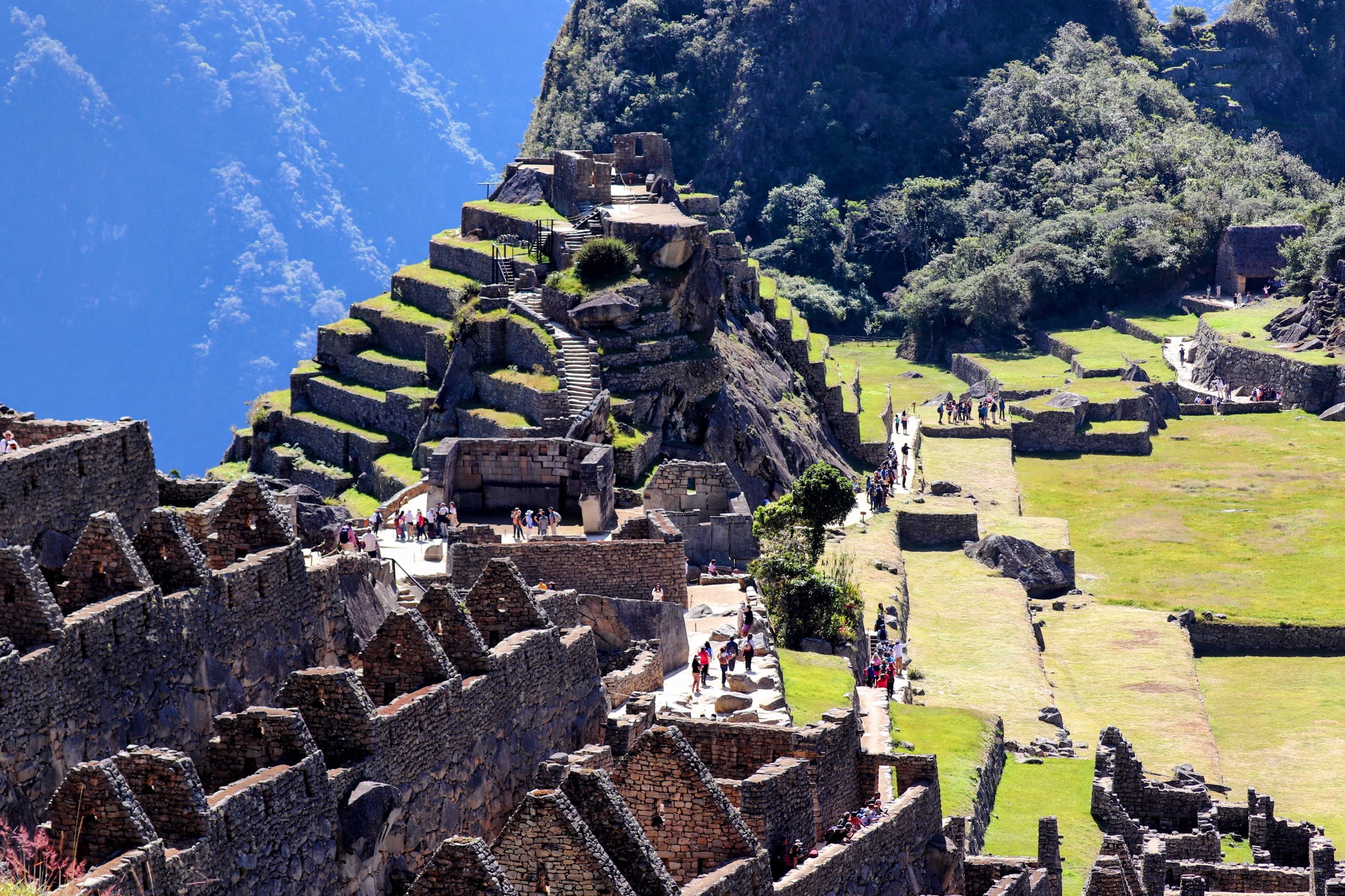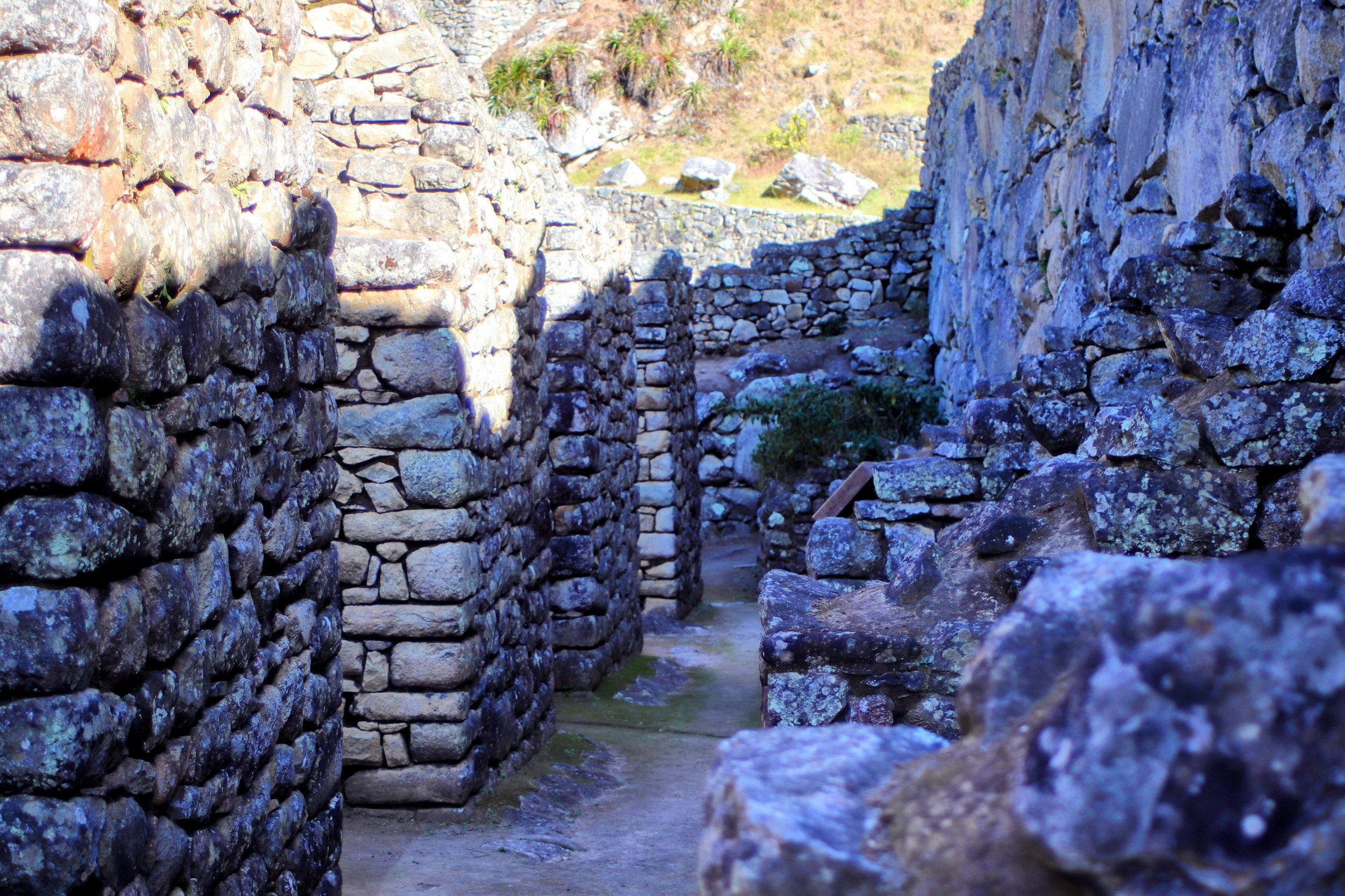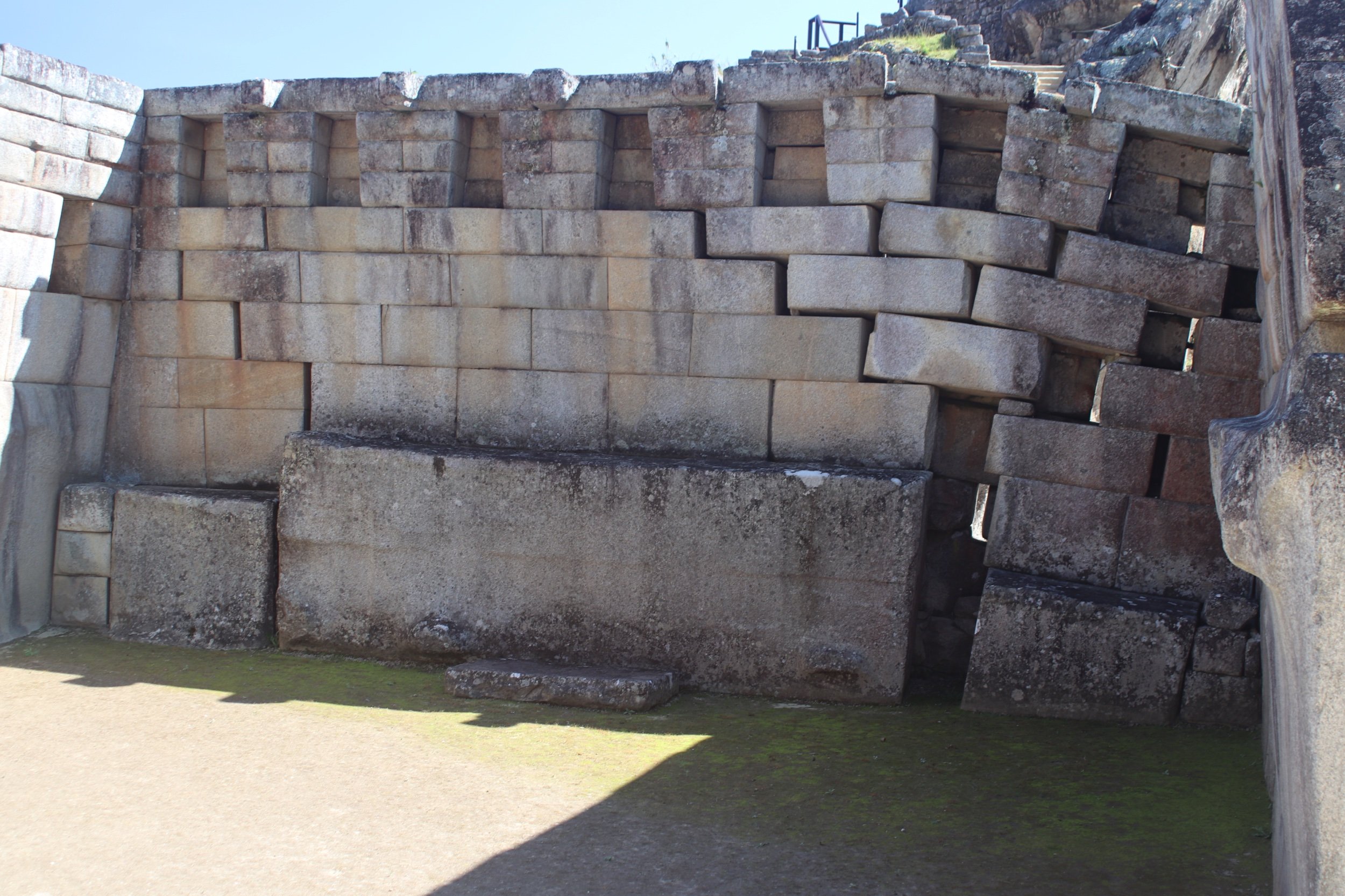The Hiram Bingham Train & Machu Picchu
We decided to skip breakfast in the morning so that we could sleep in before getting up to catch our car to Poroy Station. While we appreciated the extra hour of sleep, we didn’t appreciate being hungry and uncaffeinated.
There are a couple of train options to get from Cusco to Aguas Calientes (the city below Machu Picchu): the regular Peru Rail train, or the luxurious Hiram Bingham train. I think you can guess which one we chose for our 3.5 hour train ride.
When we arrived at Poroy station, we were the last ones to check-in even though the train wasn’t departing for 30 minutes. I guess everyone else wanted to start their journey early with mimosas and live music:
The train looks gorgeous on the outside, with the deep blue cars and gold writing:
They even laid out a blue carpet for boarding:
After appreciating the train and the entertainment at the station, we were shortly shown our seat in the dining car. But before we got too comfortable, we took some time to take some pictures of the various cars on board. As I just mentioned, there was the dining car, where we would be served lunch later on during the train ride. The wooden decor, white linens, and ornate furniture made us feel like we were on the Orient Express. (Ironically, Belmond, which operates the Hiram Bingham train route, also operates the Orient Express in Europe. Maybe we’ll do that sometime):
There were two dining cars on this train, with one side of the train set up for tables of four, and the other side for tables of two.
The next train towards the caboose, which is the last train in this case, was the bar and outdoor viewing car. The wooden decor continues on towards these cars, along with plush couches and chairs, brass railings and many windows from which to enjoy the views during the ride:
At the bar, you could enjoy as many Pisco sours and other alcoholic drinks as you want. We chose to drink some lattes and pastries because we were hungry and chose one of the two tables in the bar car. We found the couch and the chair there far more comfortable than sitting at our dining table:
There was a dedicated server in our area of the bar car, so we were never lacking in drinks and food. After drinking a couple of lattes, Nick decided it was time for a Pisco Sour, which he enjoyed while appreciating the wonderful views of the train ride:
Further back was the outdoor viewing area, which also contained cushioned benches and tables, as well as a live band. They played various covers of English songs, and some in Spanish, and also one in Chinese. On board, there were two people from Malaysia, and the band was informed of this, so they learned a song in Mandarin for them. I was impressed with their dedication to their performance:
This was, by far, the busiest part of the train, as many of the passengers spent their train ride drinking and enjoying the music there, as well as the panoramic views the car offered.
As we were arriving at Ollantaytambo station to pick up additional passengers, we were directed to go to our table as lunch was about to be served. The morning Hiram Bingham service includes a 3 course lunch:
We started off with some bread, and then an appetizer of cured trout on a corn tartlet:
Our main course was beef skewers with corn and a chili pepper sauce:
I forgot to take a photo of dessert, but it was a refreshing passion fruit mousse.
Now that we were stuffed with food, we had arrived at Aguas Calientes to disembark and take a 25 minute train up to Machu Picchu. Since we were staying in Aguas Calientes for a night, we first needed to find a representative from our hotel to take our luggage before we boarded the bus. It took a few minutes to navigate the chaos at the station, but we found him and soon our bags were being delivered to our hotel, where they would be waiting for us in our room after we finished our trip to Machu Picchu.
For those who didn’t book the Hiram Bingham train, you can purchase bus tickets at the bus station to take you up and down the road to Machu Picchu. For non-Peruvians, at the time of writing this blog, the cost was $12USD one-way, and $24USD round trip per person (there’s no discount for the round trip ticket, but it does save you the time of having to wait in line to buy another one-way ticket).
There is another option to get up to the entrance to Machu Picchu, and that’s to hike it. While on the bus going up, we could see the stairs that you would take if you were to hike it, and yeah, it’s a lot of stairs. But according to the map, it’s only a one hour hike:
At the entrance to Machu Picchu, we were told that there are no bathrooms inside the archaeological side, and that we should use the bathrooms at the entrance station. For us, the bathroom was free, but otherwise it would cost 2 Peruvian Soles per person.
We broke off into smaller groups for the guided tour of Machu Picchu, with our tour guide, Silvio, starting us off by climbing some stairs. Even though Machu Picchu is lower than Cusco, it’s still around 8000 feet above sea level, so the stairs were still tough. But once we got to the top, we got some amazing views of Machu Picchu:
I feel like we spent over 30 minutes here enjoying the views, taking photos, and listening to Silvio talk about the history of Machu Picchu. Short version: we don’t know the real name of Machu Picchu; it was named by an American, Hiram Bingham, after a nearby mountain (and in Quechua means Old Mountain). He was led up there by a local farmer in 1911, and like all white westerners being shown something by a local, he was hailed as discovering a lost Incan city when he returned and showed photos to National Geographic. They funded an archaeological expedition and he returned, excavated a bunch of graves and shipped it all back to Connecticut. Thankfully, Yale decades later returned most of it when the Peruvian government asked for their heritage back.
The Incas didn’t have a written language, so we don’t know all the details, but this city was established as a religious site by the son of Pachacutec, the 9th Incan king who united much of western South America as a single empire. His sons later fought a civil war for power when the Spaniards arrived and took advantage of the situation as part of their conquest. Thankfully, the leader at Machu Picchu ordered the city abandoned when runners came with news of the invasion, and they successfully kept all knowledge of it a secret from the Spanish. Hence why it sat empty and forgotten for almost 400 years.
We had great weather when we visited, but even in winter, it got hot in the sun. But it made for some great photos:
We continued through the agricultural part of Machu Picchu and headed into the residential areas, where we could get up close with the buildings. Because the Spaniards never discovered Machu Picchu during their conquest, much of it remains intact, which is amazing given how long it has been there. There were many store houses and homes, but the areas with the best architecture were the ones used for religious ceremonies and for high ranking members of the empire:
Among the buildings were some llamas and alpacas, who call Machu Picchu home…so cute!
After our 2.5 hour guided tour through Machu Picchu, it was time for the final part of the Hiram Bingham service: afternoon tea at the Belmond’s hotel at Machu Picchu, the Sanctuary Lodge. It was a nice treat after spending a hot afternoon at Machu Picchu:
Because we weren’t taking the Hiram Bingham train back to Cusco, we had to buy our own bus ticket to get back down to Aguas Calientes, but that was easy because there was a ticket booth in the Machu Picchu station. We were soon back down to the town, and checked into our hotel before heading into the city of Aguas Calientes before it got too dark. The woman at the front desk gave us a map, but also said that it’s a small town, but showed us on the map where the central plaza is, so that was our first stop.
As we were walking, we could see from below the many bridges that cross a river in the center of the city:
We didn’t really research the city too much before we arrived, but just walking around, it was beautiful and lively. At the plaza, it looked like some event was being setup, but we weren’t sure for what. We guessed maybe some political speech based on the seats and reserved names on the seats. We didn’t stay around to see what the event was, and the next day, the stage and seats were gone:
We continued our theme of walking up stairs and hills by going up one of the streets in the city. At the top is a hot spring, but we weren’t really interested in going there, and didn’t want to put in the effort to walk all the way up there. During our walk, we saw many statues representing important people in Incan history. We also found many, many places to eat. Even though the town was small, you would never be hungry there. While we had no plan for our evening in Aguas Calientes, much like our other trips, we really enjoy wandering and getting ourselves lost in the city and taking it all in:
It was dinner time, and we decided to eat at the hotel, which we found out afterwards was included with the room, so yay, free dinner!
The next morning, we got up early to enjoy our complimentary breakfast at the hotel, and then bought a round trip bus ticket for Machu Picchu because yes, we’re going again for a second time, but this time by ourselves. Currently, to restrict the number of visitors to Machu Picchu, you have to purchase timed entry tickets, and even then, once you enter, you have to choose one of four walking routes. They are all one way, and you can’t really go on another route once you’ve started. There are multiple people inside who will yell at you if you start backtracking, so yeah, plan which route you want to take before going. For us, we chose route 2, which is technically the same as our guided tour the day before.
However, there are some alternate paths even along that route which we weren’t able to take with the group yesterday, so we still got some new views. And more importantly, we could move at our own pace this time so Nick could get artistic with the photography:
The other exciting spot we were able to see this time, because it’s only available for part of the day, was the temple of the Condor. It’s shocking to imagine how they positioned this giant boulder levitating, supported by the neighboring rocks to create the rough image of the bird:
We also got much closer to the resident llamas this time:
After enjoying our personal experience in Machu Picchu (and getting a little tired of dodging tour groups), we took the bus back down. There was a lot of time to kill before our 3pm train, so we dropped into a very cute coffee shop for a snack and coffee. Not gonna lie, Jerry chose this place purely for the logo:
But, we got two cappuccinos, a giant empanada (they’re all huge in Peru compared with Argentina) and a cinnamon bun for just a few dollars, and made good use of their slightly flaky wifi. Since we still had time at this point, we decided to try and catch the earlier train, so we popped into the station. The ticket counter had what was likely a 30 minute line full of confused tourists, so we gave up quickly and resigned ourselves to wandering the town. There’s a newish riverfront park full of statues and plaques that cover a lot of Inca history (mostly through positive descriptions of the Incan rulers):
And then we stumbled across the secondary office for Perurail accidentally. It was clearly more for locals, but Nick got a chance to leverage his weak Spanish to navigate moving our reservation to the earlier train. We felt bad because they bumped us ahead of helping the two locals who were waiting. The attendant had to make a phone call because it was so close to the train departure (well, less than an hour), but we squeezed into the earlier train, grabbed our bags that were stowed at the hotel, and went straight to the station again. While waiting, we payed twice as much for another empanada and a cookie as we’d paid at the coffee shop, but them’s the train station prices.
On the ride to Ollantaytambo, we got a couple surprises. First, instead of boarding from the platform at the station, they walked us out and down some stairs to the section of track right in front of our hotel from the previous night (we could have saved dragging our luggage around quite a bit had we known!). On board, we got surprised with some kind of clown/demon doing a dance, which included dragging a passenger (a 20-something man) out of his seat to dance with the demon for, like, 5 minutes (about 4 more than the guy seemed comfortable with):
Finally, the staff held a “fashion show,” mostly just to showcase alpaca-wool clothes that they then wheeled out to offer for sale (not pictured, because… weird). There were a lot of great views along the way, including some gorgeous snow-capped mountains:
In Ollantaytambo, Nick negotiated poorly with a cab to get a ride to our hotel (I mean, still cheaper than going a few blocks in Manhattan, amiright?). The cabbie then apologetically explained he was helping a friend, and some guy jumped into the passenger seat and got a ride for a few blocks, before getting back out and grabbing something from the trunk. It’s good that we’re laid back about these sorts of things, but I should have asked for a discount for the shared ride (kidding).
As we were checking into our hotel, the Rio Sagrado, they mentioned the baby alpaca feeding was about to start. So, Jerry got them to hustle us down to the field so we could get a few photos and attempt to pet them. They’re kinda skittish and hopped away when we got too close, but they are so cute:
Now we’re finishing out the evening with some spa time, dinner at the hotel restaurant, and getting to bed early again so we can have our big Sacred Valley tour tomorrow.























































